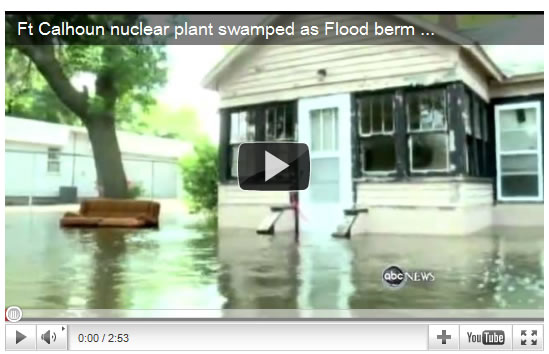U.S. Nuclear Accident May Be Imminent at Fort Calhoun Nebraska Nuclear Plant
Politics / Nuclear Power Jun 27, 2011 - 05:38 PM GMT While the mainstream media guardians have been napping, we published a comprehensive article warning the public of the dangers present at Ft Calhoun. Now we are told that the flood berm has now collapsed after being punctured by “an unidentified piece of machinery“. Our big media stars and knuckle-dragging elected officials should be reminded here that this plant’s rod pool holds 20 years worth of spent fuel rods from all plants in the state plus 1/3 of of the rods that were removed during a recent refueling that was just accomplished.
While the mainstream media guardians have been napping, we published a comprehensive article warning the public of the dangers present at Ft Calhoun. Now we are told that the flood berm has now collapsed after being punctured by “an unidentified piece of machinery“. Our big media stars and knuckle-dragging elected officials should be reminded here that this plant’s rod pool holds 20 years worth of spent fuel rods from all plants in the state plus 1/3 of of the rods that were removed during a recent refueling that was just accomplished.
Now it appears that back-up generators are working to cool the nuclear materials (sound familiar?). OPPD spokesman Jeff Hanson said the transfer was precautionary because of water leaking around the concrete berm surrounding the main transformers. If they loose cooling around the fuel rods, this will be as bad- or worse, than the meltdown at Fukushima, Japan. This story could be reaching a critical climax, and there is nothing but silence. Don’t say we didn’t warn you, although we are praying this situation is not going to escalate.
-
CNN
June 27, 2011
A water-filled berm protecting a nuclear power plant in Nebraska from rising floodwaters collapsed Sunday, according to a spokesman, who said the plant remains secure.
Some sort of machinery came in contact with the berm, puncturing it and causing the berm to deflate, said Mike Jones, a spokesman for the Omaha Public Power District (OPPD), which owns the Fort Calhoun plant.
The plant, located about 20 miles north of Omaha, has been shut since April for refueling.
“The plant is still protected. This was an additional, a secondary, level of protection that we had put up,” Jones said. “The plant remains protected to the level it would have been if the aqua berm had not been added.”
Parts of the grounds are already under water as the swollen Missouri River overflows its banks, including areas around some auxiliary buildings, Jones said.
In addition to the berm, authorities have put in place floodgates and other barriers to help protect the facility, like sandbags.
The 8-foot-tall, water-filled berm, 16 feet wide at its base, surrounded the reactor containment structure and auxiliary buildings, according to the Nuclear Regulatory Commission.
NRC officials are still denying there is any danger after nuclear plant flooded yesterday.
“We built the plant up high enough based on history, based on the flooding in the past. If the flood would rise for some reason above that level we have taken precautions, again, per our procedures to sandbag the important equipment for the reactors,” said Dave Van Der Kamp, with the Nebraska Public Power District.
He said the chances of floodwater getting into the building where the core is kept are almost zero.
The plant is designed to withstand waters up to 1,014 feet above mean sea level, according to the OPPD. The river currently stands at 1,006.3 feet and is not expected to exceed 1,008 feet, the OPPD said.
Heavy rainfall in Montana and North Dakota, combined with melting snow from the Rocky Mountains, have sent the Missouri surging downstream this summer. The river washed over and punched through levees in nearby northwestern Missouri, spurring authorities to urge about 250 nearby residents to leave their homes.
The 6 to 12 inches of rainfall in the upper Missouri basin in the past few weeks is nearly a normal year’s worth, and runoff from the mountain snowpack is 140% of normal, according to forecasters.
It was catastrophic flooding from Japan’s March 11 tsunami that knocked out cooling systems at the Fukushima Daiichi nuclear power plant, resulting in three reactors melting down and producing the worst nuclear disaster since Chernobyl. This year’s Midwestern flooding has also led to a spate of rumors about the Fort Calhoun plant that OPPD and the NRC have been trying to knock down.
The utility has set up a “flood rumor control” page to reassure the public that there has been no release of radioactivity from the plant. An electrical fire June 7 did knock out cooling to its spent fuel storage pool for about 90 minutes, but the coolant water did not reach a boiling point before backup pumps went into service, it has said.
Editor Patrick Henningsen
© 2011 Copyright Patrick Henningsen - All Rights Reserved
Disclaimer: The above is a matter of opinion provided for general information purposes only and is not intended as investment advice. Information and analysis above are derived from sources and utilising methods believed to be reliable, but we cannot accept responsibility for any losses you may incur as a result of this analysis. Individuals should consult with their personal financial advisors.
© 2005-2022 http://www.MarketOracle.co.uk - The Market Oracle is a FREE Daily Financial Markets Analysis & Forecasting online publication.




